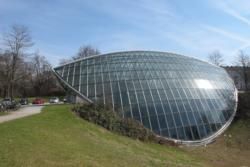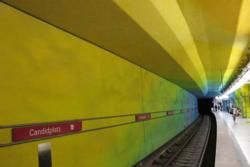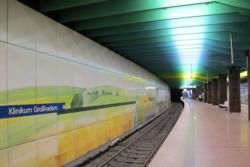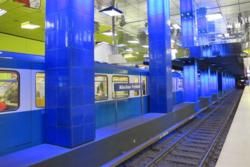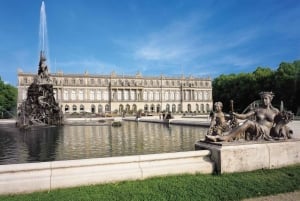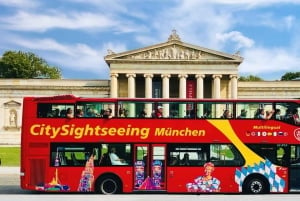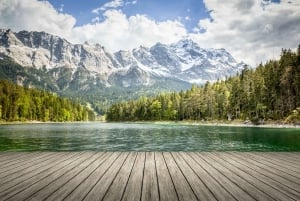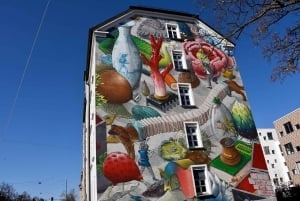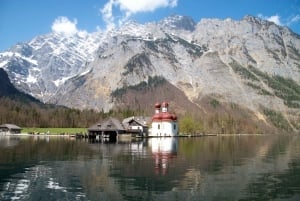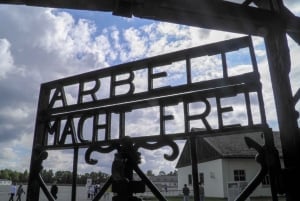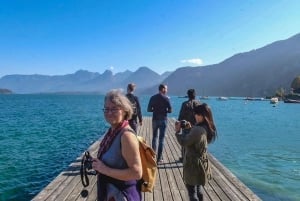Beautiful Underground Stations
The hidden beauties of Munich`s underground
Since December 2010 Munich has 100 underground stations. Some of those hundred stations under the city are real artworks and definitely worth a visit.
If you have bad weather, why not buy a day ticket and discover the world under the ground?
We have visited the 15 most interesting stations and have put together the information for you.
Moosach (U3) since December 2010
Artist: Martin Fengel
Number 100 of Munich`s underground stations awakes Spring Feelings! With the nearly 8 meter high plant and animal motives, the artist wanted to display the meeting point of city and land life. He used motives of the nature of Moosach and the surrounding area and enlarged them macroscopical.
The station is one of the most charming in Munich!
Moosacher St. Martins-Platz (U3) since October 10
Artist: Masayuki Akiyoshi
The characteristic of this station is the mosaic of 76.200 pictures (11 x 15 cm), which are decorating the 120 meter long and the 5 meter high walls. All photos were taken in the surrounding areas of Moosach and display the nature, architecture and infrastructure of this area. The pictures are displayed in a chronologic order and therefore showing the colorful sequence of the seasons.The mosaic with the title "Frost" is framed with corrugated iron that has been fixed at the ceiling.
The whole station has no columns at all, a lot of daylight and together with the additional 50 big lamps that were installed at the ceiling it gives a warm and friendly atmosphere.
Viewing all the diverse pictures of the mosaic you will surely not be bored while waiting for the train to come.
Georg - Brauchle Ring (U1) since October 03
Artist: Franz Ackermann, Architect: Burkhard Schäffer
This underground station was named after "Georg Brauchle" who was once the second mayor of Munich.
The motto of the station is "The big journey" which is illustrated with photos of places all over the world, but also of the surrounding areas of the station. Between the colorful rectangular wall areas you can find pictures from Berlin, New York, Los Angeles, Sao Paulo, Istanbul and even from the temples of Ankor Wat in Cambodia. The hall is without any columns, very bright and clear. In the year 2005 Ackermann received a price for the design of this station.
Westfriedhof (U1) since May 98
Architecture office: Auer+Weber, Lightdesign from Ingo Maurer
The lightening concept of this station is unique and creates a very special atmosphere.
11 big lamps with a diameter of 3,8 meters are glowing in red, blue and yellow. There is no daylight at all at this underground station and due to the dimed light you get the feeling to be in a cave.
Candidplatz (U1) since November 97
Architecture office: Egon Konrad
This underground station was named after the painter and sculptor Pieter de Witte who`s pseudonym was Pietro Candid.
Pietro Candid produced in the 16th century a few pieces of art and altarpieces for the residence and for some churches in Munich.
The station is fixed with a few supporting columns in order to withstand the soil and traffic pressure of the overlying buildings as the station is in a curve and is crossed by the candid bridge.
The walls, columns and the ceiling of the station are in purple, red, yellow, green and dark blue colors in the same structure like a rainbow.
Dülferstrasse (U2) since November 93
Architects: Peter Lanz und Jürgen Rauch, Mural: Ricarda Dietz
The underground station Dülferstrasse and the same named street were given their name in memory of the famous mountain climber Hans Dülfer.
The lower area of the station`s walls are decorated with colorful glass plates in the colors of the rainbow. Those plates are of different sizes.
From this station you can directly enter the shopping mall "Mira" which is also worth a visit, not only because of the shops, but because of its characteristic facade.
Königsplatz (U2) since Oktober 1980
Design: Professor Josef Wiedemann and Johannes Segieth
The „Königsplatz" (Royal Plaza) is the connecting point of Munic`s art scene. In the area around Königsplatz you can find some of the most important museums, such as the three "Pinakotheken", the "Gyptothek", the State Collection of Antiques and the "Lenbachhaus".
The station was designed by Professor Josef Wiedemann together with Johannes Segieth. Up to 4 meter high, true to the original reproductions of global art are showing pieces of the museums that you can find in the surrounding area. Furthermore there are small glass cases within the columns, which are displaying small exhibits.
Even the floor has its own characteristic, because in within the Azul-Granit Plates you can admire white mosaic artworks.
Münchner Freiheit (U3, U6) since October 1971 and newly renovated since January 2010
Design: Paolo Nestler Light design: Ingo Maurer
The station „Münchner Freiheit" (translated it would be "Munich`s Freedom") is in the opinion of some people the "Highlight below the city", others think that the blue and yellow color combination is a bit too daring.
Paolo Nestler planned this station together with the municipal underground department and 1971 the station was in operation for the first time.
Since 2010 it has been completely renovated and redesigned, however the existent architecture has not been changed. The platform area however, such as the pavement, furniture, panelling as well as the lightening and coloring concept was completely renewed.
Ingo Maurer has converted this busy junction of the public transport in a fresh, contemporary and modern station.
I hope that people can be effected by the power and the freshness of this station and experience the use as a moment, perhaps unconsciously, the lifts their Spirit 'and their mood. " Ingo Maurer March 2010
Theresienwiese (U4,U5) since March 1984
Architect: Alexander Freiherr von Branca
The name of this station says it all: Here is the place where every autumn the biggest beer festival of the world takes place - the Octoberfest!
In the middle of the station you can see a supervision pulpit from where the crowd, that is passing through this station during Octoberfest, can be controlled.
The whole station is in designed in the colors of Munich „black" and „yellow" which are in perfect combination with the wall paintings of Ricarda Dietz.
Garching (U6) since October 2006
Department for Undergroung Construction of the local building board MunichAbteilung
The station is approximately 17 meters below the ground and is located in the middle of Garching, the neighboring city of Munich.
The first thing you notice when you go to this station is the design of the station name. The "A " in the word "Garching" is designed like the egg-shaped cupola of the first research reactor, the so-called "Atomei.
Also unusual for the Munich U-Bahn stations, is the fact that the ticket machines are located directly on the platform.
The walls are decorated in the colors of Garching. White, red and green paintings of artists from Garching, are attached to the walls. Exhibition showcases are showing changing exhibits of Garching associations and institutions and can be admired on the platform.
Mirrors and painted panels as well as lots of light make this platform to an enjoyable place to wait.
Garching - Forschungszentrum (U6) since October 2006
By Paul Kramer
As the name already reveals, the station takes you to Munich's research institutes, such as the Technical University and the Max-Planck-Gesellschaft.
This can be already seen in the design of the station as the walls are decorated with 26 large boards that are displaying themes of well known researchers and inventors which have had a relevance to Munich.
Among others, one finds personalities like Albert Einstein, Rudolf Diesel, Max Planck, Claude Dornier and Willy Messerschmitt.
The 12 modern ceiling lights are in star-shaped order.
St. Quirin Platz since 9th November 1997
Architect: Hermann + Öttl Architekten BDA
The architecture of the station is unique, because a glass copula has been built above the platform.
Rough and untreated piles are forming the walls of the station. The ceiling is equipped with reflective aluminum panels which create a spacious room effect. Both outside and inside, this station is special.
Hasenbergl since October 1996
Architects: Braun, Hessel Berger; Light Design: Paul Kramer
The special feature of this station is the lighting design. The lens-shaped reflector design on the ceiling creates a really exceptional lighting effect. The light is furthermore reflected through the glass panels and mirrors on the walls. Therefore the entire station is full of light.
Lehel since October 1988
Wall design: Peter Frese; Office: Brückner & Partner
Because of its location and proximity to the Isar river, the station was built deep under the ground. Due to numerous galleries, museums, offices and administrations that are in the vicinity, the decoration of the station was chosen accordingly. Sculptures and display cases of various exhibits can be admired while waiting on the platform.
Marienplatz since 01/10/1971; expanded 2006
Architect: Alexander von Branca
Marienplatz is the busiest subway station in Munich, because from here one can reach all important sights of the old town. It was designed by Alexander von Branca and in 1971 it was in operation for the first time.
After the decision for the construction of the Allianz Arena, the station was enlarged with additional pedestrian tunnels in the period from spring 2003 until summer 2006 in order to ease the passenger flow. The expandation cost was around 46 million €.
The special features of the station are the orange walls and mirrored surfaces on the pillars.
Klinikum Grosshadern since May 1993
Wall design: Eckard Hauser, Architect: Paolo Nestler
The station is located in the suburban area of Munich and in order to illustrate that, the walls were painted with images of the scenery of the Alpine foothills of Munich. The ceiling is designed in accordance with the paintings in green and blue.
Unusual are the two, 9-meter-high glass pyramids at the entrance of the station. The original plan was to build the pyramids twice the size, following the example of the Louvre in Paris. However, due to the high costs, this has not been realized.


